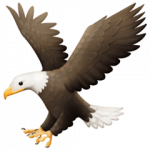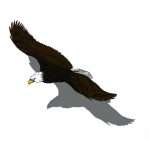August 10: Look to the west for Venus and the slender crescent of the new moon.
August 11/12: The most memorable night of the month when the Perseid meteor shower is at its most spectacular in a dark sky without a moon. The Perseids are an extended shower from mid- July to mid-August, but this will be the best time for them starting at 2am.
August 16: The moon is in Scorpius close to Antares, the red heart of the scorpion. Enjoy the rich areas of the Milky Way and the center of our galaxy.
August 20: The moon now is in Capricornus close to Saturn.
August 22: The Sturgeon Moon: The Full Moon in August is named after North America’s largest fish, the lake sturgeon. This month’s full moon is also a Blue Moon, the third Full Moon of the summer.

The fabulous Perseids
August is the month for meteors, and this year it will be one of the best for enjoying the Perseid meteor shower. The shower will be at its height on the night of August 11-12. The moon will be a slender crescent which will set soon after dusk. Up to 100 meteors per hour should be visible in our dark skies. The meteors will emerge from the constellation of Perseus, which will be on the north-eastern horizon in the beginning of the evening. The best time to watch will be from about 2am until dawn. The numbers should slowly increase throughout the morning hours, except for occasional bursts and gaps as the earth turns to face forward in our orbit. These meteors are typically the size of a grain of sand, blown away by the sun from the icy nucleus of a comet. In the case of the Perseids, the “mother ship” is Comet Swift-Tuttle. They eventually, after many passes of the comet around the sun, fill in its orbit, such that every time we cross the orbit we catch some of these tiny particles. Each of these tiny particles enters our atmosphere at a speed of nearly 40 miles per second. Each becomes white hot due to friction with the atmosphere. These tiny particles are harmless, but the nucleus of the comet is dangerous. With a diameter of 16 miles, it is twice the size of the object that killed the dinosaurs and other life forms some 65 million years ago. The nucleus is best described as a dirty snowball, having formed during the very early years of the solar system when water vapor and small dust particles were in the cloud that eventually became the solar system.
Swift Tuttle has a period of 133 years, and has made many close approaches to the Earth in the past. There were even some calculations in 1992 that predicted a possible collision with the earth on August 14, 2126. More precise measurements of its orbit led to recalculation of its orbit, which indicates that there is no threat to the Earth over the next two thousand years. It is now recalculated that the comet will pass 14.2 million miles from Earth on August 5, 2126, far beyond the moon. Whew!
However, another close encounter with Earth will occur in the year 3044 and another in 4479, each with a probability of impact of 1 in a million. But the threat still remains. Comet Swift–Tuttle is by far the largest near-Earth object, asteroid or comet to cross Earth’s orbit and make repeated close approaches to Earth. Further and further in the future these calculations become increasingly uncertain. With a relative velocity of some 40 miles/sec, such an impact would be unfortunate!
The comet has been described as “the single most dangerous object known to humanity.” I would hope that “humanity” will be able to protect itself in a few thousand years.
What irony! These silent, beautiful, harmless meteors pouring into our sky from the constellation of Perseus have come from such a dangerous object.

The meteor that became dangerous
The Chelyabinsk meteor entered Earth’s atmosphere over Russia on 15 February 2013. As we know now, it was a 66 ft diameter asteroid with a speed of 20 miles per second, small compared to comet Swift-Tuttle, but still potentially dangerous. It became what is known as a superbolide. a meteor brighter than the Sun. Skimming across the earth’s atmosphere at a shallow angle, it burst over Chelyabinsk at a height of 18.5 miles. The explosion generated a bright flash, a hot cloud of dust and gas and a dangerous shock wave. The bulk of the object’s energy was absorbed by the atmosphere. The total energy of the event was a shocking 400–500 kilotons of TNT, 26 to 33 times as much energy as that released from the atomic bomb detonated at Hiroshima. It was the largest known natural object to have entered Earth’s atmosphere since the 1908 Tunguska event, which destroyed a wide, remote, forested, and very sparsely populated area of Siberia.
Its explosion created panic among local residents, many of whom rushed to windows to watch the brilliant but silent flash of light in the sky. But it was not silent for long, and about 1,500 people were injured seriously enough to seek medical treatment. All of the injuries were due to indirect effects rather than the meteor itself, mainly from broken glass from windows that were blown in when the shock wave arrived, some 2 minutes and 30 seconds after the explosion. It is so very fortunate that the meteor exploded in the sky. If its trajectory had led it to the earth, the result would have been a horrendous human tragedy.

The Chelyabinsk meteor originated in the asteroid belt between Mars and Jupiter. It was a fragment of a colossal collision between asteroids deep in the past, a collision that threw it in our direction. Analysis of the meteorite indicates that it had experienced a high-pressure shock that had partly melted it. The melting indicates that the asteroid had a history of collisions and was once several miles below the surface of a much larger asteroid.
Unlike the “dirty snow ball” of the comet Swift-Tuttle, these asteroids are fragments of a rocky object that almost formed a planet between Mars and Jupiter, but was prevented from forming because of tidal forces exerted on it by Jupiter. What two extraordinarily different genealogies have led to the Perseid and Chelyabinsk meteors!


